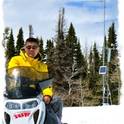
We present evidence that the de-trended, boreal winter sea surface temperature anomalies (SSTA) in the western North Pacific (WNP) are a skillful predictor for the development of the El Niño-Southern Oscillation (ENSO) by the following winter. The WNP shares some similarities with the Meridional Mode (MM) located in the subtropical central and eastern North Pacific: both are linked to off-equatorial SSTA and low-level wind anomalies, and both appear to be strongly related to wintertime variability in the North Pacific Oscillation (NPO). However, in contrast with the MM, the WNP is associated with an opposite-signed SSTA dipole located off southeastern Asia and in the western tropical Pacific, which is accompanied by equatorial winds that may influence the level of oceanic Kelvin wave activity that precedes ENSO events.
